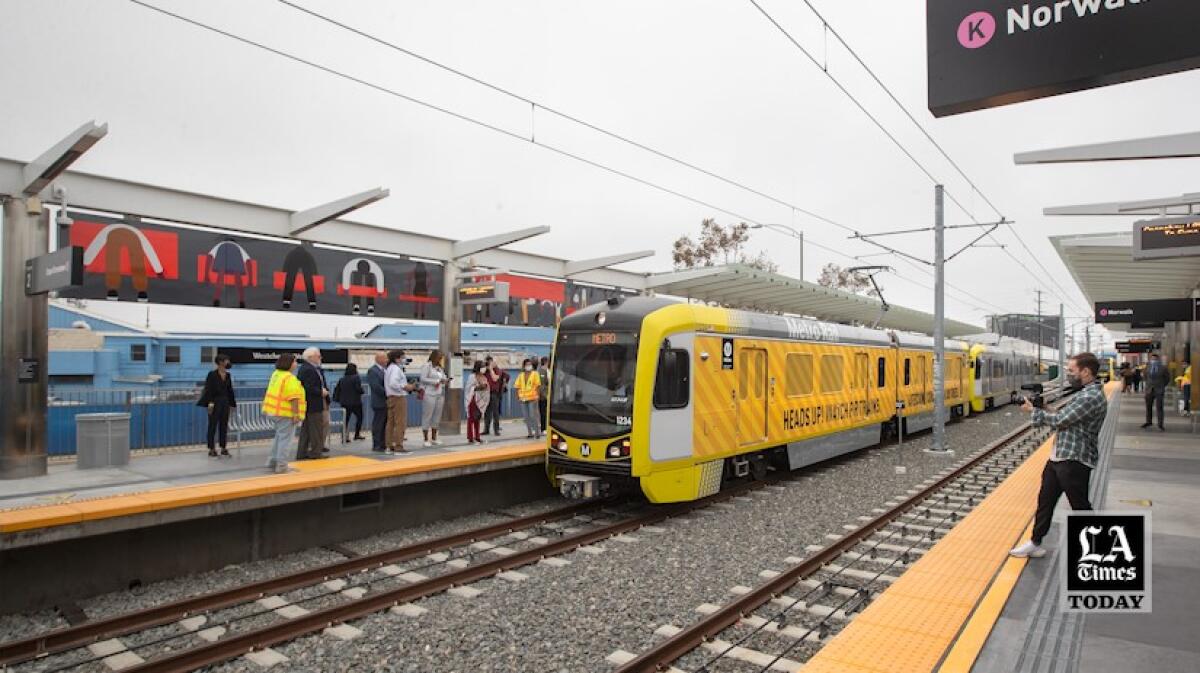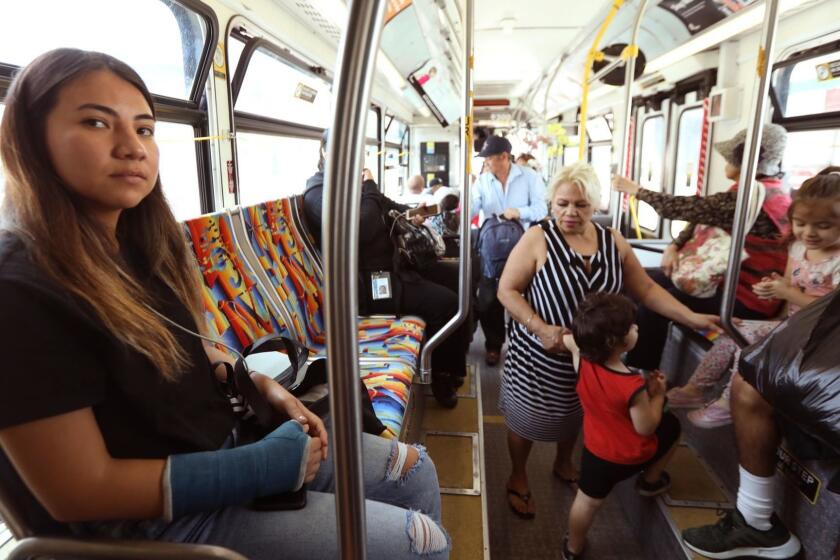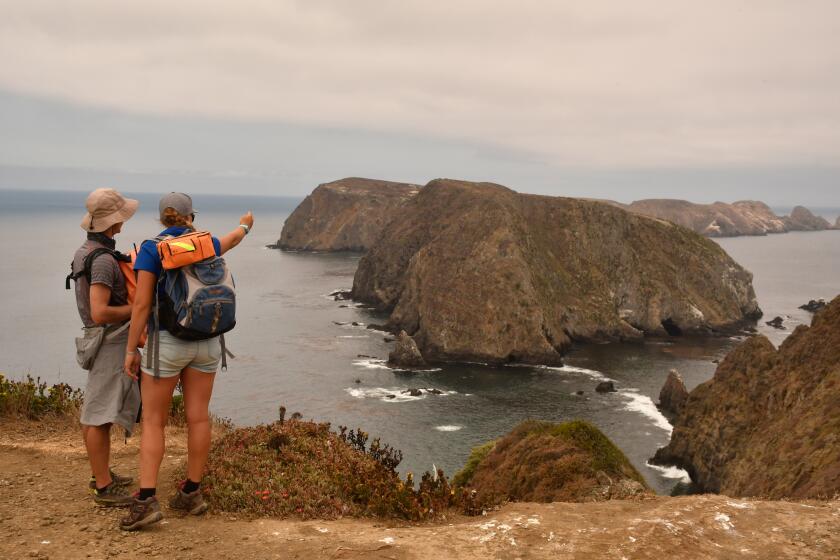Should L.A.’s train and bus rides be free? Karen Bass may soon decide

- Share via
Should it be free to use the public rail and bus systems in Los Angeles County? That’s a question incoming Mayor Karen Bass may soon have to answer.
As one of Mayor Eric Garcetti’s last acts on the Los Angeles County Metropolitan Transportation Authority board, he revived a conversation about free bus and rail service. On his last day, Garcetti asked the agency to study what such a change would entail.
It’s an issue that Bass — who will replace Garcetti on the board, which has 13 voting members, and will appoint three others — will be forced to deal with this summer, when the study is due to be delivered.
Ending fares will be an early test to see whether she can follow through on a campaign promise and balance some of the sticky issues involved.
Critics and even supporters say the switch could add to an influx of homeless people that has kept some commuters off buses and trains. And it would not be cheap: Early estimates by Metro place the cost of eliminating fares countywide at $1 billion a year. On top of that, Metro analysts say, such a move could endanger state and federal funds tied to fare collection.
Proponents believe legislative solutions can be found, and the costs could be met with new sources of revenue and savings from the elimination of fare collection and enforcement.
“I don’t think we should have barriers to the use of public transportation,” Garcetti said. “We don’t do that on our roads. We don’t do that on freeways. We tax the poor to use transit but not better-off folks to use the road.”
Garcetti, who didn’t always think fareless transit was possible, said he changed his mind after Los Angeles found a way to keep buses free during the COVID-19 pandemic. One way to offset the cost, he suggested: congestion pricing, forcing some drivers to pay tolls when traffic is heaviest.
“The promise of free transit, with a small fee for those who can afford it in cars, seems to be well worth it,” he said.
Metro is looking to see if the congestion pricing program, now used on freeways, can be expanded to downtown or other areas, but there’s been no plan on how it could be implemented or where the proceeds would go.
Transportation experts say congestion pricing is a great way to encourage commuters to take public transit, but drivers are likely to grouse. In New York, a plan to charge $23 for a rush-hour trip to Manhattan is meeting a wave of opposition.
A spokesperson for Bass, Zach Seidl, declined to elaborate on how the new mayor would approach the question, only to say that she “has been an advocate for fareless transit and looks forward to working to improve our public transportation system.”
There are many questions about what “free” means for the transit system. Will it lure more commuters? That could drive up the cost but may reduce cars on the road — a larger climate goal. Or is it largely a subsidy for the region’s working poor? Will it bring in more homeless people, possibly deterring commuters? Could new streams of revenue be better directed toward improving service with faster buses, more bus lanes and more cleaning and maintenance?
Can transit officials make buses and trains safer without more police? A new program will put 300 unarmed ambassadors as violence rises on the system.
Social justice activists have been pressuring the agency to act swiftly.
“The sooner the better,” said Alfonso Directo Jr., advocacy manager for Alliance for Community Transit. “Riders need this help now. This is an economic stimulus that transit riders can absolutely feel today.”
The household income for 62% of Metro riders is less than $24,000. About 687,000 people ride the bus on an average weekday.
Those riders got relief during the pandemic, when Metro temporarily ended fares as a way to enforce social distancing; bus riders entered in the back door, not the front, where fares are collected. The move gave advocates and commuters a glimpse of a fareless system.
While it helped those who lost jobs during the pandemic, it brought a wave of unhoused people seeking shelter, which thrust Metro into the role of social service agency, forced to find homes for those sleeping on trains and buses and in stations. Safety and sanitation became top concerns among riders, according to a recent survey.
“It’s a delicate balance,” said Oscar Zarate, a director at Strategic Actions for a Just Economy. Zarate, who wants to end fares, said many of the group’s members who use public transit sometimes feel unsafe. But he said the new ambassadors program, with customer service representatives having a presence on the Metro system, has eased fears, and increasing the frequency of buses could keep commuters from waiting on streets, where they might feel at risk.
“We want fareless transit, we want better service, we want safety — because all of them together are going to create a system that is truly a sanctuary for everybody,” he said.
The free rides ended this year as federal stimulus dollars began to dry up, but pandemic-era programs helped propel the issue of free fares in Los Angeles and across the country. Washington, D.C., became the largest city to offer free service after its City Council voted this week to waive fares for Metrobus rides.
Last fall, Metro took steps in the same direction in L.A. County. The agency launched a $50-million, two-year pilot program that makes it free for most students to ride Metro and made participating municipal buses free just as schools began to reopen. The program was paid for by one-time federal funds and is due to sunset in July.
The number of students taking transit more than doubled over the last year, and GoPass, as the program is called, has been a bright spot for Metro Chief Executive Stephanie Wiggins.
One study suggests that not having to worry about paying for transportation improves student performance: At Rio Hondo College, students with a transit pass had a 27% higher graduation rate.
Officials are looking into how such a program might be extended to low-income riders, the majority of transit users.
At the same time, Metro officials have been trying to figure out how to make buses and trains more attractive to Angelenos who have cars that can take them to their destinations faster. The agency will be pouring billions of dollars into building rail lines over the next decades, but critics say free fares aren’t likely to help.
“Los Angeles has pretty bad transit service, and making bad transit service free doesn’t really attract a whole lot more ridership,” said David Bragdon of TransitCenter, a New York-based advocacy and research group. “They need to be thinking about making transit better, rather than making bad transit free, because bad transit — even when it’s free — isn’t very attractive.”
Bragdon points to a 2018 UCLA study that found that ridership is declining in part because of increased car ownership.
Michael Manville, one of the authors of the study and associate professor of urban planning at UCLA, said that trend is probably more pronounced since the pandemic. Though there are no data available, it is likely many regular transit riders who were essential workers now have cars, Manville said.
“Once you have a car,” he said, “you are not going to go back or are less likely to go back to the bus.”
To be on time for her 9 a.m. class at Cal State Northridge, Yurithza Esparza has learned the hard way that she needs to be at the bus stop no later than 6 a.m.
The cavernous Metro stations were nearly empty at the height of the pandemic, except for workers and those who slept there. But commuters have slowly returned, as Metro has tried to improve the system with a flurry of programs to move homeless people into housing, clean up graffiti and introduce the unarmed ambassadors to foster a sense of safety.
On a weekday morning at Union Station, Talia Sonrisa and a friend boarded the Metro subway B Line on their way to Los Angeles City College. Sonrisa isn’t enrolled in the student program and said she didn’t mind paying for transit.
“There are already so many homeless people in here,” she said. “At least if people pay, they will keep it clean. But all the time you feel as if something is going to happen to you.”
As the doors to the train closed, Elisheva Glaser, a 24-year-old actress from East Hollywood, headed toward the turnstile. She carries a Taser because the transit system can get “sketchy” at night, she said. She doesn’t own a car and would love for transit to be free.
“They should definitely do it,” she said, clutching the skateboard she uses to ride from bus to rail. Besides, she said, “most of the time I see people who don’t pay.”
Metro is the country’s third-largest public transit system, but unlike its counterparts in New York and the Bay Area, it doesn’t rely heavily on fares.
Tickets this year make up less than 5% of Metro’s transit operating budget. Before the pandemic, the figure was about 17%.
In contrast, fares account for more than 60% of the Bay Area Rapid Transit budget and accounted for about half of New York’s Metropolitan Transportation Authority budget before the pandemic.
“Fares are not a huge value in the Metro budget. It’s a fraction of the overall budget,” said Eli Lipmen, executive director of MoveLA.
His group has advocated for a slower approach to a free system by expanding the student program first.
“For us,” he said, “it’s how do you create the ridership, the future and how do you create a culture that is no longer the culture of what we know as Los Angeles, a car culture?”
His group backed legislation to fund transit for students across California, but Gov. Gavin Newsom vetoed it this year, saying the state didn’t have the funds.
Manville said history shows that the strategy can work. Fare cuts in the 1980s boosted ridership as many school districts shoveled students onto public transportation instead of their own buses, but it didn’t bring in more riders with cars.
Los Angeles — with its wide boulevards, surfeit of parking lots and low-density housing — was made for the automobile. Congestion pricing could lure some to public transit and ease traffic, he said, but the policy should not be tied to free fares.
“It’s backward,” he said. “You wouldn’t want to justify congestion pricing by saying you can reduce transit fares.”
It’s disappointing, he said, to see the idea raised by Garcetti just as he exits.
“On the way out the door, he’s for this controversial policy that he has let lie fallow for years,” Manville said. “This has been kicking around the Metro boardroom for years, and he has been avoiding it.”
But Garcetti said lifting the fares could be a transformative move for the region.
“I think the public and [the board] deserve a good, honest look about how you could do that, could pay for it,” Garcetti said. “It could be the most revolutionary thing that we could do for the climate, for poverty and for ridership going up.”
More to Read
Sign up for Essential California
The most important California stories and recommendations in your inbox every morning.
You may occasionally receive promotional content from the Los Angeles Times.
















